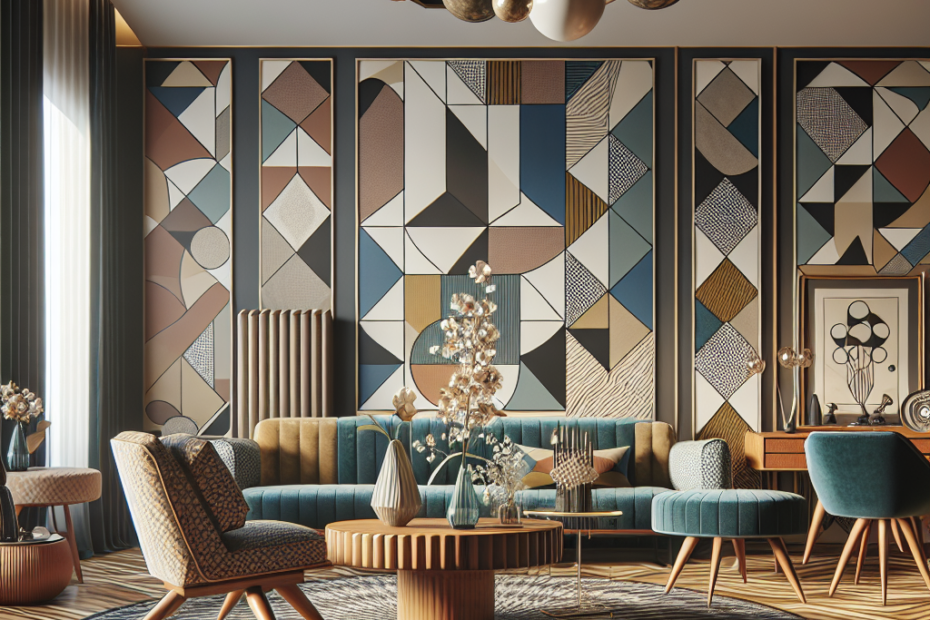“`html
The Bold Beauty of Geometric Patterns in Mid-Century Modern Interiors
They often find themselves enchanted by the timeless appeal of mid-century modern interiors. This design style, which gained popularity from the 1940s to the 1970s, is making a profound comeback. Among its key elements, geometric patterns stand out as a bold and striking feature. Geometric Patterns in Mid-Century Design include clean lines, bold colors, and simple shapes. These elements combine to create a dynamic yet understated aesthetic.
The Essence of Geometric Patterns in Mid-Century Design
Geometric patterns are more than just shapes and lines. They embody a philosophy of design that balances form and function. Mid-century modern designers embraced these patterns to create visual interest without sacrificing the usability of spaces. As they integrate elements like circles, triangles, and zigzags, these patterns can influence everything from wallpaper and textiles to furniture and decor.
Statistics and Trends
According to a market analysis by Statista, the mid-century modern furniture market is growing by 4% annually. Among these, designs featuring geometric patterns are particularly popular. In 2022, a survey by Design Within Reach revealed that 32% of interior designers prefer using geometric patterns to add visual interest to spaces. By integrating these timeless designs, homeowners and designers are investing in aesthetics that have proven to endure through the decades.
| Year | Preferential Rate for Geometric Patterns |
|---|---|
| 2020 | 28% |
| 2021 | 30% |
| 2022 | 32% |
Applications and Elements
The application of geometric patterns in mid-century modern interiors varies widely. They use these patterns in wallpapers to create feature walls that capture attention. The repetition of geometric shapes in wallpaper can make rooms feel larger and more connected. In textiles, a single line or shape can be repeated to create a feeling of rhythm and harmony, pairing well with the minimalistic nature of mid-century furniture.
Furniture is another realm where these patterns shine. They can be found in the structure of chairs, tables, and even lighting fixtures. The geometric lines are not just decorative; they also contribute to the functionality of the furniture. This combination of beauty and practicality helps to keep spaces stylish and efficient.
The Role of Color
Color plays a significant role in the effectiveness of geometric patterns. In mid-century design, they often opt for colors such as mustard yellow, olive green, and teal. These colors complement the natural materials commonly used, such as wood and leather. Together, they create an atmosphere that is warm and inviting yet stylish and sophisticated.
Modern Revival and Adaptation
Modern interior design continues to draw inspiration from mid-century principles. Today’s designers might incorporate these timeless patterns with a contemporary twist. They use new materials and technologies to reinterpret classic designs for modern audiences. This approach keeps the aesthetic fresh while honoring its rich historical roots.
Key Takeaways
- Geometric patterns are a cornerstone of mid-century modern design, adding visual interest and maintaining simplicity.
- There’s a growing annual interest in mid-century modern designs, specifically featuring geometric patterns.
- Geometric patterns enhance the aesthetics of interiors through varied applications in wallpaper, textiles, and furniture.
- Color complements patterns, with mid-century palettes like mustard yellow and olive green being favored.
- Modern designers adapt mid-century elements using new materials, keeping the style relevant today.
FAQ
- What defines geometric patterns in mid-century design?
- How popular are geometric patterns today?
- In what ways can geometric patterns be used in interior design?
- What colors complement geometric patterns in mid-century design?
- How are geometric patterns adapted in modern-day design?
Geometric patterns in mid-century design are characterized by clean lines, simple shapes like circles and triangles, and a balance of form and function.
Geometric patterns remain popular, with a growing preference in interior design, as shown by a 32% preference rate among designers in 2022.
They can be incorporated into wallpapers, textiles, furniture, and decor to enhance visual interest and unify interiors.
Colors such as mustard yellow, olive green, and teal are commonly used to complement geometric patterns in mid-century design.
Designers today adapt geometric patterns by using new materials and technologies, keeping the style fresh while honoring its historical roots.
“`
